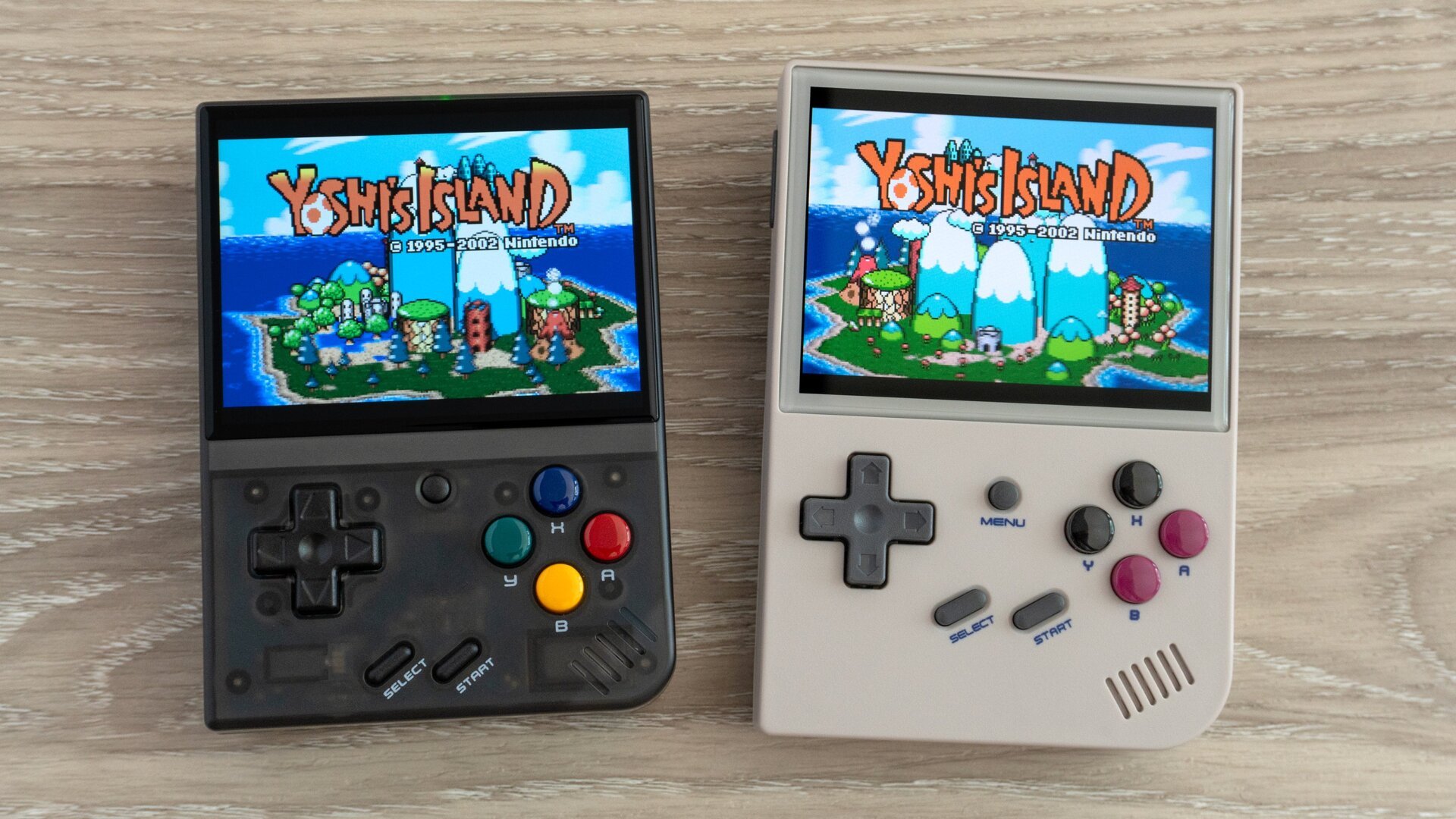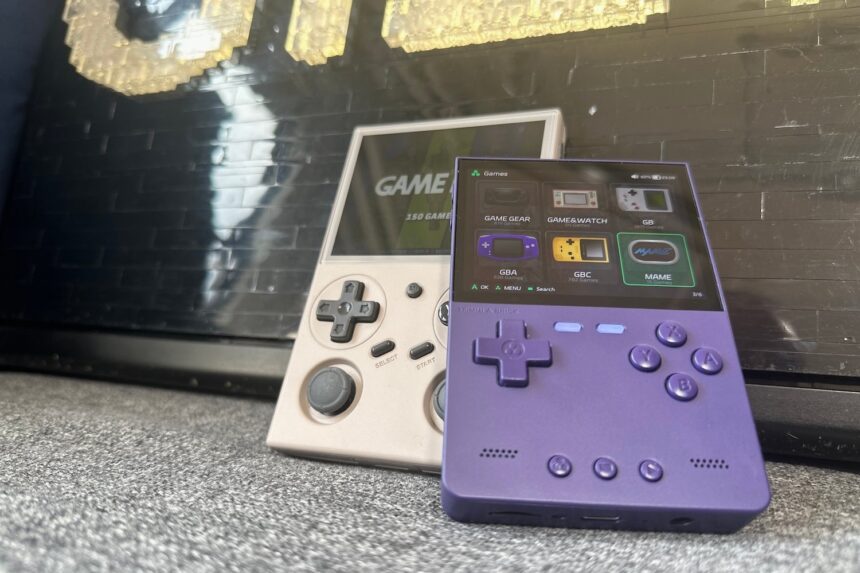The future of the cheap retro gaming handheld is looking grim, and it couldn’t come at a worse time for gamers looking for a cheap and well executed fix. The upcoming Switch 2 is set to sell for $450, $150 more than the starting price of 2017’s original Switch. The PS5 is going up in price in some regions. Games themselves will cost $70, $80, or even $100. All these price hikes should only help propel the legion of great-feeling, excessively cheap handhelds to even greater stardom. Unfortunately, Trump’s tariffs are set to hit small businesses and niche hobbies even harder than the biggest players who can afford to cajole the capricious chief executive into making an exception. Retro handhelds are almost certain to increase in price, and by a lot.
The situation surrounding tariffs are so fluid, there’s no telling where gaming will end up when (if) the chaos ends. As it currently stands, consoles don’t get a carveout from tariffs that other electronics like smartphones will. Aubrey Quinn, a senior VP at the largest gaming industry trade group, the Entertainment Software Association, told IGN earlier this month that tariffs would have “a real and detrimental impact” to every aspect of the gaming industry. She was mostly referring to the big players, like Nintendo, Sony, and Microsoft, plus those companies that make games and peripherals for them. She wasn’t talking about the small-time retro handheld makers offering super-cheap devices for playing games via emulation. These devices are—by themselves—completely legal, though they sometimes ship with ROMs, or “read-only memory,” which are typically copies of games that came out years ago but may still be under copyright. It leaves some retro handhelds in a legal gray area, though their emulation capabilities are the reason many retro fans adore them.
Other major industries with lobbying power may be able to argue for exceptions to the Trump tariffs, but small makers of niche products don’t have much leverage, said Gad Allon, a professor of operations at Wharton University of Pennsylvania. Allon told me in a phone interview that “gaming is not the top of concern from Trump, but Apple is.” And yet, the iPhone maker may still increase prices one way or another. The only hope for U.S.-based companies is to band together in a bloc that could potentially latch onto another exemption, he said. For China-based gaming companies, the only real hope if these tariffs remain is to find another country outside China for manufacturing.
Smaller brands that focus on gaming emulation—which imitates gaming consoles hardware as a form of software—have had a golden age under past trade policy. Last week, I followed my own advice and decided to buy not one, but two retro handhelds for less than $100 before the tariff-massacred market made buying one untenable. I’m already enamored by their old-school feel and massive potential even with their relatively low-end specs. I bought both devices through AliExpress, a China-based site used by small brands to ship to other countries—especially the U.S.—for cheap.
Part of the reason I could get those handhelds for so little is the same reason companies like Temu and Shein have been able to send ultra-cheap packages to the U.S. It’s called the “de minimis” exemption, which exempts packages valued at $800 or less from added duties when shipping to the U.S. It was an exemption carved out of the Tariff Act of 1930 by the U.S. Congress for gifts, but it was expanded in 2015 under President Barack Obama in order to promote more free trade. Now, under Trump, the exemption is almost guaranteed to meet its demise.
“De minimis is going to disappear,” Allon said, adding it’s likely the only definite new trade policy we can count on in today’s cesspit of international economic negotiations.
The de minimis exemption has made enemies on both sides of the political divide. Critics have complained the rule undercuts U.S. businesses that try to sell slightly-higher quality products for slightly more money. Trump’s “Liberation Day” tariffs that sent the stock market into panic also laid out a new duty rate for shipments from China. They specified a 30% tax for the value of a shipment or $25 per item. On Tuesday the administration tripled down on these policies, and Trump has said he wants to levy 90% of that value, or $75 per item. That will increase to $150 per item on June 1. These duties will effectively become a tax on every U.S. resident who wants to buy a product from China.
For retro gamers, this could possibly triple the price of all those once-cheap handhelds. By this summer, an Anbernic RG35XX—which in the retro community is considered a modern classic Game Boy-style emulation handheld—would jump from for $50 MSRP to over $90 or $200 at minimum. A Retroid Pocket 5—which is used for emulating games from the GameCube era or beyond—sits at $220. In a few months, it could cost $418 or lively much more considering the full sweep of tariffs. That’s nearly the price of a Switch 2 or Steam Deck.
Even if you opt to buy these devices on Amazon, tariffs are nearly guaranteed to jump the handhelds’ cost. Those tariffs could have a major impact on the brands that make these handhelds as well. Companies like Anbernic, Miyoo, Ayaneo, TrimUI, and Retroid sprang up to fill the cheap handheld gaming void left by the largest console makers. These brands mostly operate out of China, and those that don’t still rely on China for manufacturing and shipping. These device makers are known for pushing new devices out the door with reckless abandon. Anbernic just announced a new RG557 handheld that’s supposed to take on other $200 devices. This week, Retroid told customers on its Discord that it’s planning to fulfill all orders of its Retroid Pocket Flip 2 and Retroid Pocket Classic handhelds by May 2 which should avoid the tariff deadline. Just last week, Ayaneo shared more details about its horizontal Ayaneo Pocket Ace handheld and promised a full launch “in late April.” None of these companies have relayed what could happen to their products after the tariff deadline. We reached out to all three companies for comment on whether tariffs will impact these releases, but it seems the handheld makers are staying mum until—or if—the tariff situation becomes clear.
The retro handheld boom took off during the pandemic, where small retro game shops and device makers alike saw a wave of sales while people tried to ignore the tumult of lockdowns by throwing themselves into gaming’s past. Russ Crandall, a former food blogger and cookbook author, started his Retro Game Corps YouTube channel around that time. His deep dives into handhelds and gaming devices both big and small followed the retro handheld trend’s trajectory, and now his channel has 645,000 subscribers. Crandall told me over email the hobby has grown precipitously even after lockdown ended.
But that could change after the end of de minimis exemptions. So far, Crandall said he hasn’t heard anything from the many brands he works with. That likely means they’re keeping plans under lock and key while the global economic situation remains fluid. Crandall said tariffs will also impact his own hobby and his channel as he often buys many of the products he reviews. Worse, he said increased prices will impact sales of entry-level handhelds the hardest.
“The sad reality is that the cheaper handhelds are generally the entry point for a lot of newcomers, and I expect that if they are turned away by that initial purchase price; we’re going to see less growth in the handheld community,” he said.

Game Boy’s heyday is long behind us, but gamers still fondly remember when you could grab Nintendo’s first handheld for just $90 (or $231 in today’s dollars). A Nintendo DS with two times the screens started at $150 ($251 in 2025). In 2011, consumers voted with their wallets and refused to buy a Nintendo 3DS for $250. Nintendo then dropped the price to $170. Over and over, gamers prove they want small handhelds that may not match the power of a $550 Steam Deck or handheld PC like a Asus ROG Ally X, and it mainly comes down to a factor of price, portability, and games availability. IDC data shown by The Verge identified that the Steam Deck—both OLED and non-OLED models—is estimated to sell 1.926 million units in 2025, three years after launch. In 2014, three years after the 3DS first hit the scene in 2011, Nintendo sales data shows the company sold 12.2 million 3DS models that year alone, including the 3DS XL and 2DS. The Nintendo DS from 2005 was even more successful worldwide.
There is a clear itch for this kind of console, though Sony and Xbox are only now coming around to the idea of making a proper handheld PC. Nintendo abandoned the 3DS eShop in 2024, but that didn’t end the platform’s popularity. There’s an entire cottage industry of people online who make workarounds to mod and jailbreak the 3DS to run custom firmware, allowing them to install their physical cartridges or add in homebrew games and apps. Gamers who got a taste for old school single-board handhelds won’t stop just because the companies making them can no longer sell them for cheap. The hobby may remain niche, but major gamemakers could change that. Nintendo has made so many strides with its Nintendo Online + Expansion Pack, which emulates games from old-school Nintendo and Sega consoles for the Switch. It even announced GameCube games were coming to Switch 2. Imagine if Nintendo made a lightweight, lower-powered, lower-cost handheld for less than $200 that used a Switch Online subscription to play games? If the controls were spot on, it could be an instant classic and far better than the revived Game & Watch from 2020.
Retro handheld makers brought back the best aspects of the Game Boy era—mainly an attainable price, wide game selection, and excellent controls in pint-sized packages. More than that, it brought back gamers who have largely abandoned the hobby, partially due to rising costs. I plan to offer one of my two, cheap handhelds to a friend who last played games on a Nintendo Game Boy Advance SP and has dreamed of running through Pokémon Emerald Version once more. Tariffs and game companies can keep making things expensive, but the hope remains in the communities keeping these tiny consoles alive.
Read the full article here












